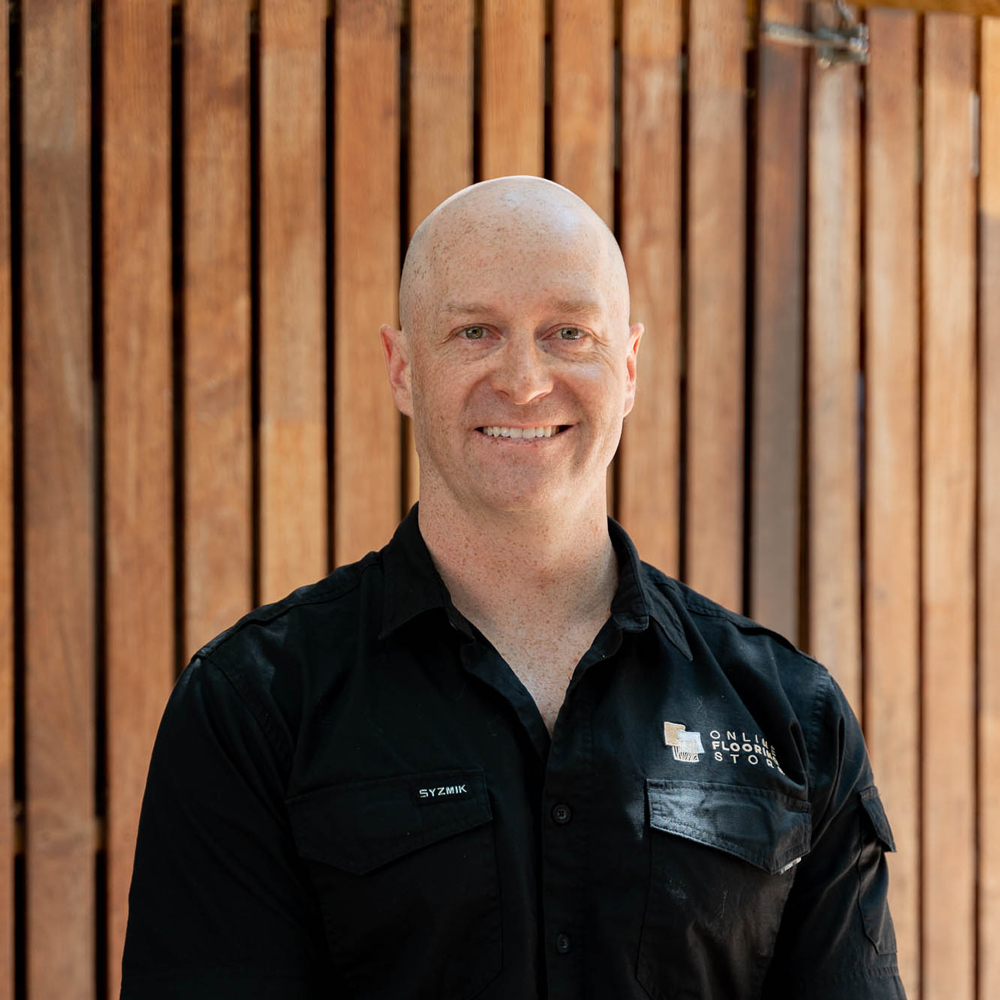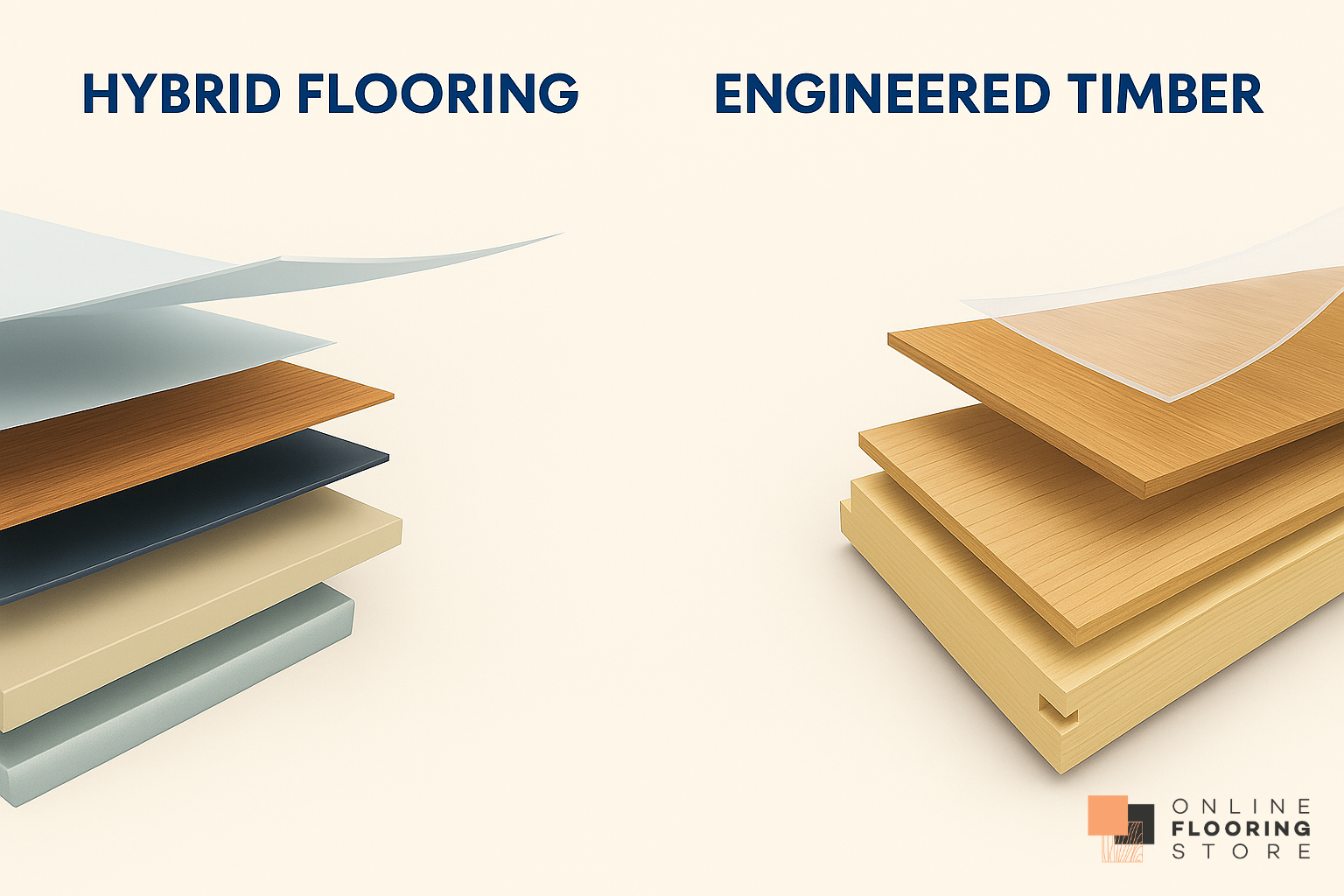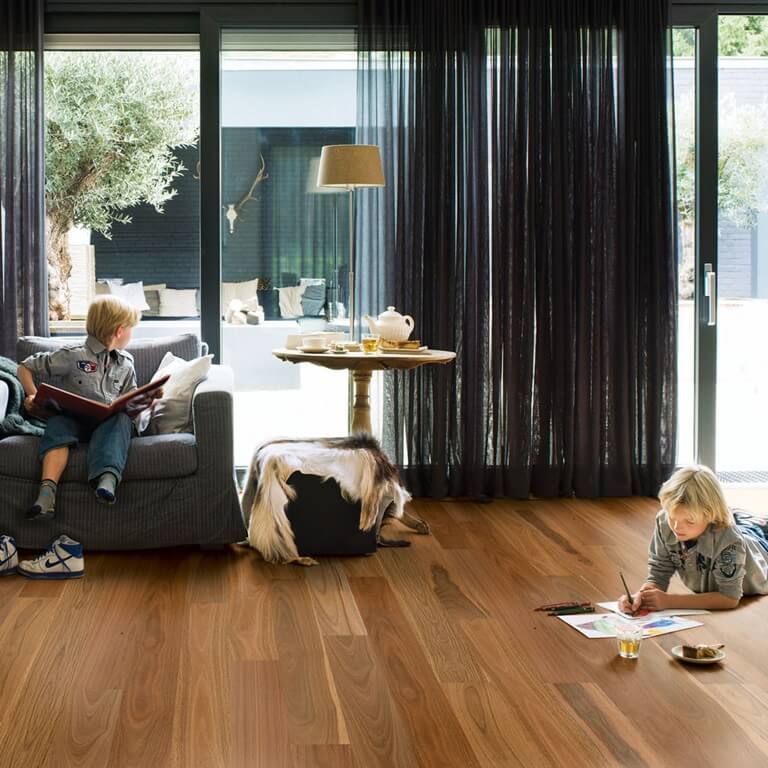If you’ve been wandering through showrooms or scrolling through flooring photos lately, you’ve probably found yourself comparing hybrid flooring vs engineered timber flooring. Both look like timber. Both can transform a space. But they live very different lives once they’re down.
Let me explain why the choice between them usually comes down to how you actually live on them day to day, not just how the floor looks on install day.
Quick Summary
- Hybrid flooring – fully synthetic, waterproof, scratch-resistant, and budget-friendly. Perfect for families, pets, and rentals.
- Engineered timber flooring – real wood veneer over a timber core. Naturally beautiful, repairable, and adds resale value.
- Hybrid wins on practicality; engineered timber wins on authenticity and long-term value.
- An attempt to merge categories—a thin timber veneer over a hybrid core; worked technically but failed the “market perception” test.
Look and Feel
- Engineered timber is the real deal. Every plank tells its own story; the grain never repeats. That uniqueness is what gives timber its wow factor and warmth underfoot.
- Hybrid flooring, on the other hand, relies on high-resolution prints and embossed textures. The look has come a long way—some patterns are so good they fool you at first glance—but over a large room, you’ll notice repeats.
“Timber’s got soul. Hybrid’s got consistency.” If you want an authentic, one-of-a-kind finish, go with engineered timber.
If you prefer a uniform style that stays exactly how it looked on day one, go hybrid.
Durability and Maintenance
Hybrid flooring is built to withstand punishment, pets, kids, prams, toy cars; you name it. The SPC (Stone Plastic Composite) core is rigid, dense, and practically immune to dents or scratches. You can wet-mop it freely, and it laughs at spills.
Engineered timber is tougher than solid hardwood but still a natural product. It can scratch or dent when heavy furniture or high heels are moved, and it doesn’t like standing water. What it offers instead is repairability. You can sand and re-coat it, sometimes more than once, depending on the veneer thickness.
“Hybrid’s the set-and-forget floor. Timber’s the one you live with and look after.”
- Hybrid wins for durability and easy care.
- Timber wins for refresh potential—you can make it look new again, years later.
Water and Moisture Resistance
Here’s the non-negotiable difference. Hybrid flooring, especially with an SPC core, is 100 per cent waterproof.
Engineered timber is moisture-resistant at best. It’s not waterproof.
In kitchens, bathrooms, or laundries, timber is prone to swelling, cupping, and delamination. Hybrid thrives in those zones, even with regular splashes and steam.
| Feature | Hybrid Flooring | Engineered Timber |
|---|---|---|
| Waterproofing | 100% waterproof SPC/WPC core | Moisture-resistant only |
| Wet-area suitability | Bathrooms, kitchens, laundries | Avoid wet zones |
| Response to spills | Wipe and forget | Must dry quickly to avoid cupping |
| Humidity tolerance | Excellent | Moderate |
Hybrid flooring is suitable everywhere, even in areas with moisture.

Expert Insights From Clem Sturgess
20+ years' experience in hard flooring
Waterproof but not Chemical-Proof
Here’s the thing — hybrid flooring is waterproof, but that doesn’t mean it’s immune to chemistry. When moisture vapour rises through a concrete slab, it can carry alkaline salts that react with the polymers in some hybrid cores. This slow process, called alkalinity hydrolysis, breaks.
The fix is simple: always lay a 200-micron builder’s plastic sheet over concrete. That $30 roll stops alkaline vapour in its tracks and saves you from thousands in repairs. Read more about alkalinity hydrolysis in hybrid flooring.
Installation and Everyday Care
Hybrid flooring uses a click-lock floating system and usually has a built-in underlay. There’s no glue, no nails, and very little prep beyond levelling the slab. Anyone handy with a tape measure and drop saw can lay it themselves.
Engineered timber can also float, but more often it’s glued down for a solid, luxurious feel underfoot. Professionals should handle that installation—you’ll need expansion allowances, moisture barriers, and proper adhesives.
Clem’s warning: “Whichever way you go, don’t skip subfloor preparation. I’ve seen slabs with more dips than a BMX track.”
- Hybrid is faster, cheaper, and DIY-friendly.
- Engineered timber demands a pro bowl touch but delivers a high-end finish.
Comfort and Acoustics
This is one of the most underrated parts of choosing a floor.
- Hybrid floors feel firm and stable underfoot thanks to their stone-plastic core. Great for heavy traffic, not so great for people who stand all day in the kitchen. They also have a slightly “clicky” sound if the underlay isn’t right.
- Engineered timber feels warmer and more forgiving. It has a natural spring and absorbs sound better—especially when glued down. That’s why you’ll find timber in higher-end apartments or open-plan homes where echo can be an issue.
If comfort and acoustics matter, timber’s the winner. If you prioritise toughness, a hybrid’s your mate.
Cost and Home Value
The price difference is clear.
| Category | Approx. Material Cost (per m²) | Install Method | Adds to Home Value |
|---|---|---|---|
| Hybrid Flooring | $35–$60 | Floating (click-lock) | Low–Moderate |
| Engineered Timber | $60–$120+ | Glued or floated | High |
- Hybrid flooring is straightforward to install and often DIY, so total project costs stay low.
- Engineered timber sits higher depending on the veneer thickness and species. Professional installation adds more, and future refinishing costs should be factored in.
However, engineered timber adds tangible resale value. Real timber still carries prestige—buyers notice it. Hybrid flooring rarely changes a valuation.
Verdict: Hybrid wins on upfront cost. Timber wins on long-term home value.
Longevity, Refinishing and Replacement Costs
Here’s where the investment really separates.
- Hybrid flooring will look great for years, but once it’s worn out, that’s the end of it. No sanding, no refinishing—replacement only. That means another round of material and labour costs every 10–15 years if it’s heavily used.
- Engineered timber behaves more like a classic car. With a quality veneer, you can sand, reseal, and recolour several times. Even after two decades, a refresh can make it look brand-new for a fraction of the cost of replacement.
If you’re staying put long term, timber’s cheaper over time. For rentals or short-term properties, hybrid wins the maths game.
Climate Suitability and Australian Conditions
Australia’s climate swings from humid to bone-dry, sometimes in the same week.
- Hybrid flooring doesn’t move much with temperature or humidity. It’s ideal for coastal areas, tropical climates, and anywhere with evaporative air conditioning that constantly changes humidity.
- Engineered timber handles moderate conditions well but still reacts to extreme moisture or dryness. In dry southern states, it’s fine; in humid coastal zones, you’ll need a moisture barrier and air-conditioning to keep expansion under control.
“Hybrid doesn’t care if it’s the Gold Coast or Kalgoorlie. Timber’s fine too—just keep your indoor climate steady.”

Expert Insights From Levi Saunders
Online Retail Specialist & Flooring Content Creator
Even engineered timber needs time to adjust before installation. Timber naturally expands and contracts with humidity, so if it’s laid straight from the box, it can swell, gap, or creak once your indoor climate changes.
Stack the boxes in the room, open the ends, and give it a couple of weeks to settle. It’s a small step that prevents big headaches later.
Learn exactly how and why to acclimatise your timber floor in our full guide: Acclimatising Timber Floors.
Environmental Impact
Engineered timber gets points for a sustainable, eco-friendly flooring option. It’s made with real wood, often from responsibly managed plantations, and it’s biodegradable if untreated.
Hybrid flooring uses synthetic materials like PVC and limestone. It’s not renewable, but it lasts a long time, which offsets some of its footprint. The newest hybrids are low-VOC and formaldehyde-free, keeping indoor air safe.
Verdict: Timber wins for renewability. Hybrid wins for longevity and low maintenance.
The Timber-Veneer Hybrid Experiment
A few years back, manufacturers tried to merge both worlds—a micro-thin real timber veneer (0.6 mm for Australian species or 1.2 mm for oaks) bonded to a hybrid SPC core.
Technically, it was brilliant. The real-timber top gave an authentic look, while the hybrid base offered waterproof stability. Early versions had curling issues in strong sun, but thicker SPC cores fixed that.
The bigger issue wasn’t engineering—it was perception. Customers who wanted timber wanted it through and through. Hybrid buyers didn’t want to pay extra for a veneer.
“It worked beautifully once we beefed up the core, but people weren’t ready for it. Timing’s everything; same story with WPC before SPC took off.”
Verdict: Technically sound, commercially misunderstood. Expect the idea to return when the market’s ready.
Real-World Buyer Scenarios
- The Busy Family Home: A young Perth couple with two kids and a dog went with hybrid. Muddy boots, spilled drinks, toy cars—no stress. They love that they can mop freely and not think about it.
- The Coastal Airbnb: For a short-term rental near the beach, hybrid again. Sand, salt, humidity—none of it worries an SPC floor. Guests can drag furniture or come in wet from the surf.
- The Inner-City Renovation: An older apartment owner chose engineered oak. They wanted warmth, better acoustics, and that timeless look for resale. Two years later, the agent said the flooring alone probably added ten thousand to the sale price.
Each story shows there’s no single “best” floor—just the right one for the setting.
Buyer Personas
- Young families and pet owners: Hybrid flooring is waterproof, scratch-resistant, and low-stress. Engineered timber looks amazing, but it wears more quickly under rough use.
- DIY renovators and investors: Hybrid saves money on both materials and installation. Timber costs more but can lift property value in resale.
- Upscale homeowners: Hybrid gives a consistent modern aesthetic. Engineered timber offers a premium, high-end feel that impresses every time.
- Design lovers: Hybrid’s prints and textures have improved dramatically, but nothing replicates timber’s natural randomness.
- Wet-area projects: Hybrid is ideal—100 percent waterproof. Engineered timber shouldn’t go near moisture.
| Buyer Type | Hybrid Flooring Strengths | Engineered Timber Appeal |
|---|---|---|
| Young families & pet owners | Waterproof, scratch-resistant, carefree cleaning | Prone to scratches; requires care |
| Investors & DIY renovators | Affordable, fast install | Adds value but higher cost |
| Upscale homeowners | Uniform look, modern feel | Premium aesthetic, higher resale |
| Design-focused buyers | Realistic prints and textures | Every board unique and natural |
| Wet-area projects | Ideal — 100% waterproof | Not suitable |
Which One’s Right for You?
If your household’s a circus—kids, pets, constant traffic—hybrid flooring is the obvious choice. It’s durable, waterproof, and forgiving. You can live on it without a second thought.
If you’re chasing warmth, character, and that feeling of real craftsmanship, engineered timber delivers in spades. It’s the kind of floor that makes a house feel finished and instantly homely.
The truth is, both are great—just for different reasons.
- Hybrid thrives on convenience.
- Timber thrives on authenticity.
The real question isn’t which is better, but which suits your lifestyle.
“Floors are meant to be lived on. If it makes you enjoy being at home more, that’s the right floor.”







